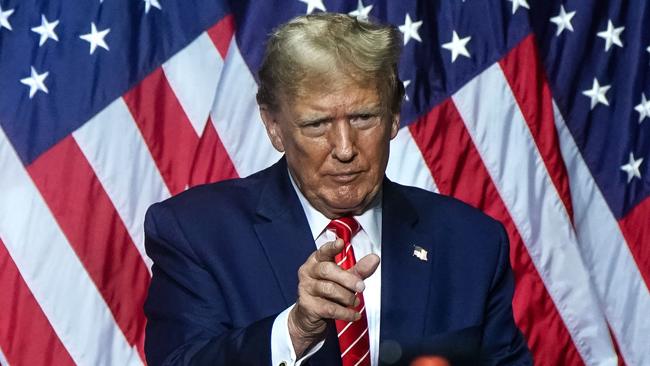Trump’s debt pile increases risks for a big shock to markets
There are growing risks that current sentiment ‘shock’ in the markets could morph into a financial or liquidity ‘crisis’. Here’s why.

Markets cycle back and forth between periods of calm and periods of heightened volatility, usually when investors have been taken by surprise.
These surprises tend to fall into two categories, and it’s important to be able to distinguish between them. The first is a sentiment shock. This is what we saw when Trump announced his “Liberation Day” tariffs. With sentiment shocks, after a period of fear, investors realise and accept the absence of contagion and move on.
The second is a crisis. It can range from economic (recession) to market (liquidity), or geopolitical (war, conflict), systemic (financial), natural (acts of God), health (pandemic) and tech (cyber).
With US national debt now at $US36.56 trillion, investors face a formidable challenge and the potential for a crisis, especially during periods of significant debt refinancing when liquidity is challenged.
One of the less recognised yet deeply harmful consequences of Donald Trump’s first term was the dramatic surge in US national debt under his administration, the consequence of the 2017 Tax Cuts and Jobs Act, which reduced corporate tax rates from 35 per cent to 21 per cent, and $US3.1 trillion in Covid-19 stimulus measures.
According to Eugene Steuerle, at the time a prominent Washington budget expert and co-founder of the Urban-Brookings Tax Policy Centre, the annual deficit’s expansion during President Trump’s first term marked the third-largest relative increase compared with the economy’s size among US presidential administrations. But unlike George W. Bush and Abraham Lincoln, who saw greater relative deficit spikes, Trump has not had to manage two foreign wars or fund a civil war.

In 2019, the Congressional Budget Office (CBO) reported that pre-pandemic deficits had reached 4.6 per cent of GDP, nearly double the projected 2 to 3 per cent, reflecting structural fiscal imbalances.
The fiscal strain Trump imposed on the US government at the time was, even back then, expected to cause long-term disruption, burdening future generations with substantial debt.
It appears a leopard can’t change its spots.
Under Trump’s second term, it’s worse. The US Treasury Department issued $US815bn in new securities in Q1 2025, a 12 per cent increase from Q1 2024, to finance deficits projected at 6.3 per cent of GDP in 2025 and 6.7 per cent in 2026.
If you have been watching the US bond market, you would be right to assume recent developments are signalling mounting investor concern.
While Moody’s recently, and inevitably, stripped America of its remaining AAA sovereign credit rating, the 10-year Treasury yield has risen to 4.59 per cent, up 10 basis points since early May, while the 30-year yield last week hit 5.08 per cent, a threshold breached only twice since October 2023. Meanwhile, a poorly received 20-year bond auction on May 20 drove yields to session highs, reflecting diminishing demand amid a surge in debt issuance.
Total debt-to-GDP now stands at 120.7 per cent, a level unseen since World War II, but unlike 75 years ago, financial commitments including social security and Medicare render a recovery much more difficult.
Foreign holders own 30 per cent of the $US28 trillion of Treasury securities outstanding and are pivotal to market stability. Japan remains the largest creditor, and the UK is now second with $US796.2bn, having passed China, whose holdings have fallen to $US765bn in March 2025, down 2.4 per cent from $US784bn in December 2024.
One concern is that Trump’s approach to foreign relations, as highlighted by his Liberation Day tariffs, has provoked retaliatory reductions in Treasury purchases. Meanwhile, equity investors should be mindful that the tariff-triggered a sell-off in bonds, with 10-year yields peaking at 4.592 per cent and the S&P 500 dropping 5.4 per cent, revealed a break in the traditional correlation between rising yields and a weakening dollar. This challenge to the traditional inverse relationship could signal potential capital flight.
Investor ‘must-watch’
Fiscal policy is rapidly becoming the investor’s “must-watch” indicator. Trump’s proposed extension of the 2017 tax cuts is estimated by the CBO to add $US4.5 trillion to the debt by 2034, while negotiations over state and local tax deductions have stalled because the bill could increase deficits by $US2.8 trillion over a decade. Over at DOGE (the Department of Government Efficiency), aims to streamline spending by $US1.2 trillion by 2030 are meeting resistance from entitlement program recipients and advocates.
And let’s not forget the debt ceiling, reached in January 2025, which now looms as a critical risk. “Extraordinary measures” are projected to be exhausted by August, and a failure to raise the ceiling could precipitate a technical default. This scenario is already reflected in credit default swap (CDS) pricing, while S&P Global’s Capital IQ model rates US sovereign credit at BBB+, six notches below Moody’s, indicating there might be worse to come.
US interest costs reached $US523bn in fiscal 2024 and are projected to double by 2035. By then, they will surpass spending on education, research, and social services combined.
The Federal Reserve’s reduced Treasury purchases – down from $US2 trillion in 2020 to $US400bn in 2024 – and a fed funds rate of 4.25 to 4.50 per cent limit monetary policy’s ability to suppress yields. Short-term borrowing, comprising 60 per cent of recent deficit financing, faces refinancing risks if rates rise.
For investors, the implications are many, and the most significant is a sentiment shock that morphs into a financial or liquidity crisis. Fears about deficits or inflation and potential rate hikes have the potential to threaten growth stock valuations. Already, the Nasdaq 100 is trailing the S&P 500 by 7.2 per cent since April. Meanwhile, the US dollar’s weakening correlation with yields suggests the flows into euro-denominated assets and gold could continue, and finally, with US Treasuries’ safe-haven status in question, allocations to private credit, REITS or infrastructure may begin to make more sense.
Ultimately, the US fiscal trajectory, compounded by debt ceiling gridlock and global trade and financial tensions, demands investor attention because, together, they have the power to fuel a crisis. We’re not there yet, but balancing yield opportunities against rising volatility and prioritising liquidity and diversification are nevertheless necessary as markets are reshaped by a shifting narrative that is fast focusing on Trump’s fiscal approach and the US’s unprecedented debt levels.
Roger Montgomery is founder and chief investment officer at Montgomery Investment Management




